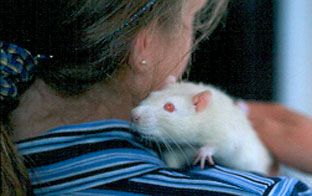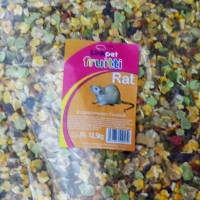- Home
- FAQs
- Customer Video Gallery
- Customer Photo Gallery
- Bird Facts
- Bird Food Blog
- Bird Information
- Feeding Advice
- Small Animal Information
- A to Z of Guinea Pigs
- A to Z of Hamsters
- A to Z of Rabbits
- Basic Care for Guinea Pigs
- Basic Care for Hamsters
- Basic Care for Rabbits
- Basic care for Chinchillas
- Basic care for Ferrets
- Basic care for Gerbils
- Basic care for Mice
- Basic care for Rats
- Buying a Healthy Small Animal
- Does your Reptile need a Licence
- Equipment for Ferrets
- Equipment for Hamsters
- Equipment for Mice
- Equipment for your Chinchilla
- Equipment for your Gerbil
- Equipment for your Guinea Pig
- Equipment for your Rabbit
- Keeping a House Rabbit
- Dog Information
- Cat Information
- Customer Information
- Fat Balls
- Suet Pellets
- Straights
- Seed Mixes
- Suet Treats
- Mealworms
- Bird Feeders
- My Account
Basic care for Rats
Rats make great companions for animal lovers of all ages, so read on and find out more about looking after this intelligent creature.
Twootz provides Fruity Rat Food and Small Animal fruity mix which are both ideal for your Rats health and well being.
Fancy (domesticated) rats are intelligent animals and, when tame, are affectionate, making wonderful companions for children and adults alike. All fancy rats are descended from the wild Brown (Norway) rat, Rattus norvegicus, and the infamous Black (Ship) rat (Rattus rattus) that was responsible for the spread of the Black Death (bubonic plague) throughout Europe during the Middle Ages. These days the majority of fancy rats’ ancestors comprise brown rats only.
Housing and bedding
Rats are happiest when they have company, so the ideal is to keep two females (does) together – either littermates or introduced to each other when young. Young males (bucks) cohabit well enough until they reach maturity and then they’ll fight.
Tip: After cleaning out the cage, replace a small amount of your rat’s old nesting material to help him familiarise with his home.
Tip: Do not site your rat’s cage near electrical appliances (televisions, computers, etc) as the noise these objects emit upsets small animals.
Tip: Rat cages should have a solid base because a wire floor will hurt your pet’s feet.
Grooming
Twootz provides Fruity Rat Food and Small Animal fruity mix which are both ideal for your Rats health and well being.

Fancy (domesticated) rats are intelligent animals and, when tame, are affectionate, making wonderful companions for children and adults alike. All fancy rats are descended from the wild Brown (Norway) rat, Rattus norvegicus, and the infamous Black (Ship) rat (Rattus rattus) that was responsible for the spread of the Black Death (bubonic plague) throughout Europe during the Middle Ages. These days the majority of fancy rats’ ancestors comprise brown rats only.
Housing and bedding
Rats are happiest when they have company, so the ideal is to keep two females (does) together – either littermates or introduced to each other when young. Young males (bucks) cohabit well enough until they reach maturity and then they’ll fight.
- Large aquariums (fish tanks) make ideal homes for rats, enabling a deep layer of litter to be provided which will allow them to burrow
- You’ll need to adapt an aquarium in order for it to be suitable for your rat by substituting the tank top for a solidly constructed lid of small-gauge heavy-duty wire (chicken wire is too light to withstand persistent gnawing) - supply a nesting-box
- Wire cages are easier to clean out and double as a climbing-frame, but choose one with a deep base so you can provide your pet with sufficient litter
- Bear in mind that many rat cages available in pet stores are too small, so work on the theory that the bigger the cage, the better it will be for your pet
- Long, narrow cages are preferred, ideally with lots of headroom and platforms on different levels with one for a nesting-box
- The recommended minimum cage size for one or two rats is 75 x 65 x 30 cm (approximately 30 x 26 x 12 inches), but a larger one would be better – and preferably with much more headroom than one foot. Width between the bars should be no more than 15mm to ensure your pet remains in situ
- Litter-wise, peat makes ideal burrowing material. Untreated softwood shavings or sawdust are other options, but some rats may suffer respiratory ailments from these products’ dust or phenol content
- You also need to provide nesting material such as clean, fresh hay or other product specifically supplied for rats - avoid straw as its spiky consistency may cause eye injuries
- Despite their poor reputation, fancy rats are clean animals providing you care for them correctly. Their cage will require cleaning out once or twice per week using a pet disinfectant to kill bacteria and neutralize odours
- If your rat’s cage smells, you are not keeping it clean enough
- Site your rat’s cage/tank away from draughts and direct sources of heat, such as radiators and sunlit windowsills
- Wherever you put the cage ensure that it cannot be knocked over and that young children or the family cat or dog won’t harass your pet
Tip: After cleaning out the cage, replace a small amount of your rat’s old nesting material to help him familiarise with his home.
Tip: Do not site your rat’s cage near electrical appliances (televisions, computers, etc) as the noise these objects emit upsets small animals.
Tip: Rat cages should have a solid base because a wire floor will hurt your pet’s feet.
Grooming
- Rats do not require regular grooming from humans as they spend a good deal of time maintaining their appearance and personal hygiene
- If you do wish to groom your rat, use a soft toothbrush
- Although unnecessary from an appearance point of view, brushing your pet may increase the bond between you







